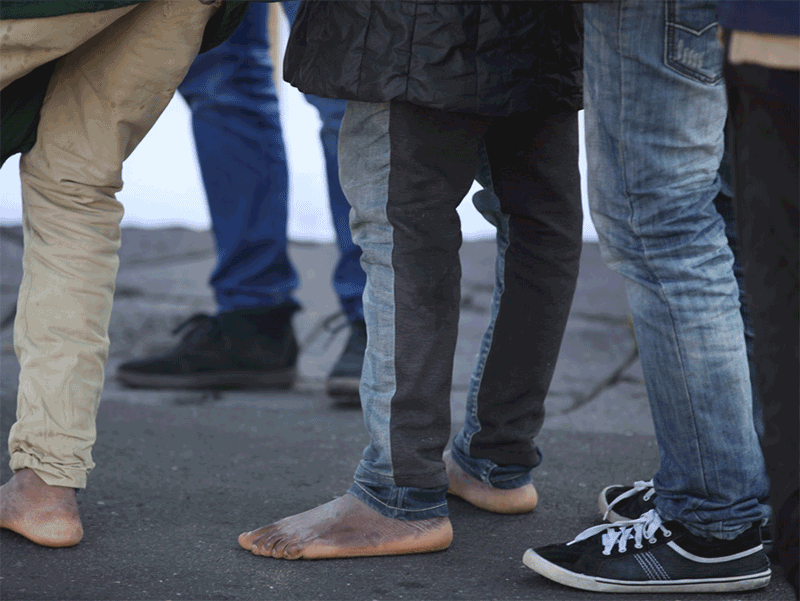Refugee Advocacy and the Meaning of ´Migrants´
6 Apr 2017
By Jørgen Carling for Peace Research Institute Oslo (PRIO)
This article was external pageoriginally publishedcall_made by the external pagePeace Research Institute Oslo (PRIO)call_made in 2017.
There is a universally accepted legal definition of ‘refugees’ but no corresponding key to the meaning of ‘migrants’. The United Nations traditionally regards everyone who changes their place of residence to another country as an international migrant. But ‘migrant’ is increasingly used in a different way, as a contrast to ‘refugees’. Although this usage is promoted in the context of refugee advocacy, it carries the risk of undermining access to protection for those who may need it. Migration dynamics are challenging to understand and manage, and redefining the meaning of ‘migrants’ is a counterproductive move.
Brief Points
- The use of ‘migrants’ and ‘refugees’ is often cast as an issue of correctness. But, in fact, there are two competing definitions of migrants.
- The inclusivist view holds that everyone who changes their place of residence is a migrant, regardless of the causes and circumstances; refugees are included.
- The residualist view holds that ‘migrants’ are a residual category, made up of those who change their place of residence without being refugees.
- The residualist view has been fiercely promoted in the context of refugee advocacy, but with potentially damaging consequences for access to protection.
- The phrase ‘refugees and migrants’ implicitly condones a residualist view; ‘refugees and other migrants’ does not.

In August 2015 Al Jazeera external pageannouncedcall_made that the network will no longer refer to ‘migrants’ in the Mediterranean.1 This word, an online editor argued, has become ‘a tool that dehumanises and distances, a blunt pejorative.’ The network’s solution is to drop ‘migrants’ and instead use ‘refugees’. The announcement was met with a groundswell of cheering in social media.
The essence of Al Jazeera’s argument is that if we sympathise with people, we should call them refugees in order to humanize them. But, as Judith Vonberg argued in her lone and brave critical external pageresponsecall_made, ‘Al Jazeera gives credence to the illiberal voices telling us that migrants are not worthy of our compassion.’
A few days after Al Jazeera’s announcement, the United Nations High Commission for Refugees (UNHCR) published a external pagenews itemcall_made on its website, entitled ‘“Refugee” or “migrant” – Which is right?’. To encourage dissemination through social media, the article was accompanied by an image of a distressed mother and two children, with the words ‘Refugee or Migrant? Word choice matters.’ superimposed.
The UNHCR does not call for dropping migrants, but asks that the people crossing the Mediterranean be labelled ‘refugees and migrants’. This stance appears to be a reasonable compromise, but is equally unsettling. It reflects the agency’s insistence that refugees and migrants are ‘external pagefundamentally differentcall_made’ from each other.
Many Interventions, including the UNHCR campaign, have been cast as a matter of clarification and correctness, but actually concealed a fundamental and simple disagreement: do ‘migrants’ include ‘refugees’?
There are two opposing views, which can be called inclusivist and residualist. The first holds that migrants are people who have changed their country of usual residence, irrespective of reason. In short, migrants include refugees. This is how the International Organization for Migration (IOM) and several other agencies external pagedefinecall_made it, along with many academics. In external pagemy opinioncall_made, the inclusivist approach is essential to the vision of migration management for the benefit of all.
Conversely, the residualist view sees migrants as people who have moved to another country for any reason other than to seek international protection as refugees. This view is promoted by the UNHCR, which has continuously external pagearguedcall_made that ‘refugees are not migrants’. The UNHCR even implies that other views are either ignorant or irresponsible – that they don’t realise that ‘external pageword choice matterscall_made’ or that they fail to take the external pagevulnerability and rights of refugeescall_made seriously.
There is nothing contradictory in using the term ‘migrants’ inclusively and ensuring the welfare of migrants who need protection as refugees. On the contrary, an inclusive definition of migrants means recognising that anyone on the move may have a well-founded fear of persecution and be entitled to international protection. The circumstances of refugees are specific ones – but so are those of victims of trafficking and undocumented migrants, for instance.
The UNHCR is making the perils of the ‘migrant’ label a self-fulfilling prophecy. The organisation external pagearguescall_made that being labelled ‘migrants’ can have ‘serious consequences for the lives and safety of refugees’. But at the same time, the UNHCR’s Communications and Public Information Service promotes an understanding of ‘migrant’ that has this life-threatening effect.
The Refugee Agency makes the case that ‘migrants’ are used by those who have a political interest in denying protection. In an external pageinterviewcall_made with The New York Times, the agency argued that since countries are free to deport undocumented migrants, but not refugees, ‘it is not surprising that many politicians in Europe prefer to refer to everyone fleeing to the continent as migrants’. This is a genuine problem, but not an argument for redefining the meaning of migrants.
Such claims about politically motivated rhetoric can also be turned around. The UNHCR is an agency that strives for influence in a crowded landscape of humanitarian and migration actors. It makes perfect sense to launch a campaign that presents a black-and-white world with two kinds of people: the special people— our people, refugees—and the other people, migrants.
The ‘two kinds of people’ rhetoric is troubling on many levels. First of all, it undermines the humanitarian principles that should guide our response to emergencies. When people drown at sea or suffocate in lorries our first question should not be ‘so, which kind were they, refugees or migrants?’ Narratives about ‘two kinds of people’, are, paradoxically, a central ingredient in many of the conflicts that thousands are forced to flee.
The UNHCR has no monopoly on defining ‘migrants’. In fact, there is no universally accepted definition, and external pagedisparate descriptionscall_made abound. The UNHCR’s approach reflects the agency’s own perspective: migrants, in their view, are the residual after refugees have been identified.
By contrast, the United Nations’ external pagerecommendationscall_made on migration statistics define an international migrant as ‘any person who changes his or her country of usual residence’. Migrants, understood in this way are people who move under different circumstances and for a variety of reasons—including fear of persecution. It corresponds to current usage by many academics, media organizations and governments. While Al Jazeera discredits the word ‘migrant’ for being an umbrella term, that is exactly why it is valuable.
People on the move are in limbo between two possible approaches to labelling. First, their reasons for departure can be used to make distinctions. Fleeing a war, seeking employment, or reuniting with family, for instance, are commonly understood motivations for migration. The challenge, of course, is that motivations can be blurred, and overlapping, defying neat categorization.
The other approach to labelling starts from the bureaucratic apparatus that migrants enter. Unlike motivations, immigration legislation is clear-cut. Some individuals are recognized as refugees, for instance, while others are given residence permits as labour migrants and yet others enter on student visas.
When someone risks their life to cross the Mediterranean on a boat, we do not know exactly what made them leave, whether they will apply for asylum, or what the outcome of their case will be. The UNHCR is right in emphasizing diversity, but wrong in insisting on a black-and-white picture. Even in retrospect, when cases have been processed, the grey area is large: more than a third of Somalis and Afghans who external pageapplied for asylum in Europecall_made in 2014 were neither recognized as refugees nor deemed to have the possibility of safe return.

The distinction between refugees and other migrants is often couched in terms of ‘having to move’ versus ‘choosing to move’. Over the past few decades, researchers have made headway towards external pagerefining this dichotomycall_made. All prospective migrants face a mix of opportunities and constraints, and make decisions that reflect multifaceted considerations. What differs is the nature of this mix; for some, the choices are few and frightening.
In a recent external pageinterviewcall_made about debates over termnology, Loren Landau said that his extensive research in Southern Africa ‘suggests that people who claim asylum or become refugees are, for the most part, little different in experiences or needs from those who don’t.’ Saying so publicly is difficult, he added, because it is seen to support the case for placing more limits on asylum.
But perhaps it is rather the UNHCR’s rhetoric that is undermining the right to seek asylum. The agency chooses to promote a definition of migrants that rules out protection needs, or, as Alexander Betts external pagehas put itcall_made, the view that ‘migrant’ means ‘not a refugee’. What we need, however, is a migration policy that takes the starting point that migrants may or may not have well-founded fears of persecution.

Determining refugee status can be a messy and unpredictable process. Caseworkers who handle applications for asylum frequently lack the resources or information to make decisions with confidence and the applicants often dispute the outcome. Many asylum seekers are denied protection in Europe, but still have a genuine fear of returning to their own country. We have no better alternative than to uphold the external pageRefugee Conventioncall_made and examine individual cases with care, but it is unhelpful to insist that refugees and other migrants are fundamentally distinct. ‘Mixed migration’ is not a checkerboard of black and white, but a jumble of different histories, resources and entitlements.
The ‘two kinds of people’ argument is further undermined by the drawn-out trajectories of many current migrants. A Nigerian arriving in Italy might have left Nigeria for reasons other than a fear of persecution, but ended up fleeing external pageextreme dangercall_made in Libya. Conversely, a Syrian might have crossed into Jordan and found safety from the war, but been prompted by the bleak prospects of indeterminate camp life to make the onward journey to Europe. Regardless of the legal status that each one obtains in Europe, they are both migrants who have made difficult decisions, who deserve our compassion, and whose rights need to be ensured.
Journalists often feel insecure about the terminology because of the perceived moral and political fallout. Some find the phrase ‘refugees and migrants’ reassuring because using both terms is a way to play it safe. Others external pageuncritically consultcall_made the UNHCR as the perceived authority on the matter, and so end up with the phrase ‘refugees and migrants’. But the more we use ‘refugees and migrants’, the more we reinforce the view that ‘migrant’ is a residual and not an inclusive term.
The UNHCR external pagerecommendscall_made the phrase ‘refugees and migrants’ to describe migration movements that may include people in need of protection as refugees. But where do we draw the line? Perhaps we can say ‘migrants’ about the tens of thousands of Indians who move to Europe every year, many of them for high-skilled jobs? If we follow the UNHCR line, we have to say ‘migrants and refugees’ because roughly 0.1 per cent of Indians who come to Europe are, in fact, recognised as refugees under the Geneva Convention. With a residualist position, it is virtually never safe to only use ‘migrants’.
The UN’s external pageinitiativecall_made to ‘Address Large Movements of Refugees and Migrants’ takes a curiously ambiguous approach to terminology. The website’s external pagedefinition pagecall_made uses the UN Department of Economic and Social Affairs’ (external pageUNDE-SAcall_made) inclusive description of migrants as people who have moved to another country ‘irrespective of the reason for migration’ alongside an explanation of ‘refugees’ from the UNHCR. So the definitions side-by-side imply that migrants include refugees. But everything else suggests the opposite view.
The very name of the initiative and external pagesummitcall_made centres on ‘refugees and migrants’, as if they were mutually exclusive categories. The residualists appear to have lost the battle of the definitions page – but won the war of the initiative as a whole.
The controversy over migrants versus refugees erupted only a few months after another debate on terminology swept through social media: why, external pageMawuna Koutonin askedcall_made, are white migrants distinguished as ‘expats’? The debates, then and now, reflect hierarchies that cast ‘migrants’ as undesirable leftovers.
We need to embrace the inclusive meaning of ‘migrants’ as persons who migrate but may have little else in common. In that way, we respect both the uniqueness of each individual and the human worth of all.
Notes
1 See electronic version for hyperlinks to sources.
This PRIO Policy Brief is based on edited extracts from two blog posts: ‘Refugees are also migrants. And all migrants matter’, originally published on the Border Criminologies blog at the University of Oxford, 3 September 2015 (http://bit.ly/refugees-are-also), and ‘The end of migrants as we know them?’, originally published on the web site of UNU-MERIT United Nations University, 19 October 2016 (bit.ly/endofmigrants).
About the Author
Jørgen Carling is Research Professor at the Peace Research Institute Oslo (PRIO).
For more information on issues and events that shape our world, please visit the CSS Blog Network or browse our Digital Library.

